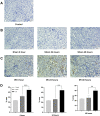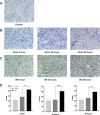Soluble Programmed Cell Death Protein 1 and Its Ligand: Potential Biomarkers to Predict Acute Kidney Injury After Surgery in Critically Ill Patients
- PMID: 35356070
- PMCID: PMC8959723
- DOI: 10.2147/JIR.S356475
Soluble Programmed Cell Death Protein 1 and Its Ligand: Potential Biomarkers to Predict Acute Kidney Injury After Surgery in Critically Ill Patients
Abstract
Purpose: Programmed cell death protein 1 (PD-1) and programmed death-ligand 1 (PD-L1) have been detected in injury kidney. However, their expressions are unclear in mice kidneys under renal ischemia-reperfusion injury (IRI). In this study, we would observe the expressions of PD-1 and PD-L1 in kidney tissues and analyze the association between the concentrations of PD-1 and PD-L1 in mouse kidney homogenate and the corresponding concentrations of soluble PD-1 (sPD-1) and soluble PD-L1 (sPD-L1) in plasma after renal IRI. Further, we explored the predictive value of sPD-1 and sPD-L1 for acute kidney injury (AKI) in high-risk patients after surgery.
Methods: This study established an AKI model induced by IRI in mice. Plasma, kidney samples, and homogenate were collected 0h, 24h, and 48h after surgery for immunohistochemistry and enzyme-linked immunosorbent assay. Then, we continuously enrolled 88 AKI high-risk patients who underwent noncardiac surgery. The biomarkers, including sPD-1, sPD-L1, and urine neutrophil gelatinase-associated lipocalin (NGAL), tissue inhibitor of metalloproteinase-2 (TIMP-2), insulin-like growth factor-binding protein 7 (IGFBP7), were detected immediately after surgery.
Results: Our data revealed the concentrations of PD-1 and PD-L1 in kidney homogenate, and sPD-1 and sPD-L1 in plasma significantly increased at 0h, 24h, and 48h after IRI. A positive association was found between PD-1 and sPD-1 (r = 0.774, p < 0.001), and between PD-L1 and sPD-L1 (r = 0.881, p < 0.001). Compared to NGAL, [TIMP-2]*[IGFBP7], sPD-1 and sPD-L1 showed better predictive abilities for AKI with an area under the ROC curve of 0.856 (95% confidence interval [CI]: 0.825-0.958, p < 0.001) and 0.906 (95% CI: 0.764-0.921, p < 0.001).
Conclusion: The increased expressions of PD-1 and PD-L1 in kidneys under IRI suggested they may play essential roles in AKI development. sPD-1 and sPD-L1 can indirectly reflect the expressions of PD-1 and PD-L1 in kidneys, respectively. sPD-1 and sPD-L1 showed excellent predictive ability for AKI in high-risk patients.
Keywords: acute kidney injury; ischemia-reperfusion injury; programmed cell death protein 1; programmed death-ligand 1.
© 2022 Wang et al.
Conflict of interest statement
The authors report no conflicts of interest or financial disclosure in this work.
Figures





Similar articles
-
Variable Expression of Programmed Cell Death Protein 1-Ligand 1 in Kidneys Independent of Immune Checkpoint Inhibition.Front Immunol. 2021 Jan 21;11:624547. doi: 10.3389/fimmu.2020.624547. eCollection 2020. Front Immunol. 2021. PMID: 33552089 Free PMC article.
-
Clinical significance of soluble programmed cell death-1 and soluble programmed cell death-ligand 1 in patients with locally advanced rectal cancer treated with neoadjuvant chemoradiotherapy.PLoS One. 2019 Feb 26;14(2):e0212978. doi: 10.1371/journal.pone.0212978. eCollection 2019. PLoS One. 2019. PMID: 30807610 Free PMC article.
-
Plasma Endogenous Sulfur Dioxide: A Novel Biomarker to Predict Acute Kidney Injury in Critically Ill Patients.Int J Gen Med. 2021 May 28;14:2127-2136. doi: 10.2147/IJGM.S312058. eCollection 2021. Int J Gen Med. 2021. PMID: 34093033 Free PMC article.
-
Will urinary biomarkers provide a breakthrough in diagnosing cardiac surgery-associated AKI? - A systematic review.Biomarkers. 2020 Jul;25(5):375-383. doi: 10.1080/1354750X.2020.1777199. Epub 2020 Jun 19. Biomarkers. 2020. PMID: 32479185
-
Diagnosis of cardiac surgery-associated acute kidney injury from functional to damage biomarkers.Curr Opin Anaesthesiol. 2017 Feb;30(1):66-75. doi: 10.1097/ACO.0000000000000419. Curr Opin Anaesthesiol. 2017. PMID: 27906719 Review.
Cited by
-
Soluble Programmed Cell Death 1 Protein Is a Promising Biomarker to Predict Severe Liver Inflammation in Chronic Hepatitis B Patients.ACS Omega. 2024 Mar 29;9(14):16716-16724. doi: 10.1021/acsomega.4c00780. eCollection 2024 Apr 9. ACS Omega. 2024. PMID: 38617617 Free PMC article.
-
Enhanced renal ischemia/reperfusion injury repair potential of exosomes derived from B7-H1high mesenchymal stem cells.Front Genet. 2025 Apr 2;16:1516626. doi: 10.3389/fgene.2025.1516626. eCollection 2025. Front Genet. 2025. PMID: 40242472 Free PMC article.
-
PD-L1 as a Urine Biomarker in Renal Cell Carcinoma-A Case Series and Proof-of-Concept Study.Diagnostics (Basel). 2024 Mar 30;14(7):741. doi: 10.3390/diagnostics14070741. Diagnostics (Basel). 2024. PMID: 38611655 Free PMC article.
References
LinkOut - more resources
Full Text Sources
Research Materials
Miscellaneous

